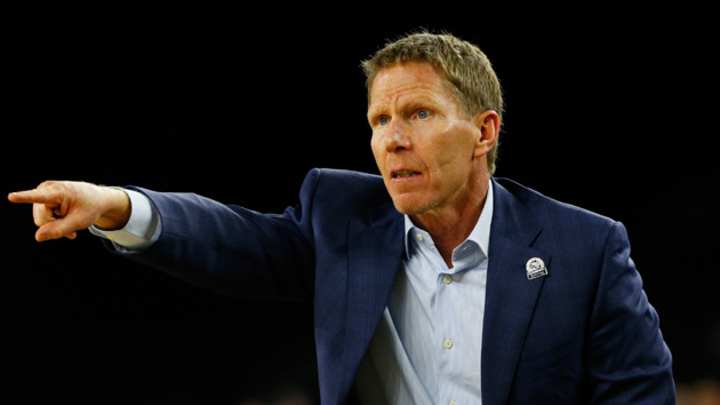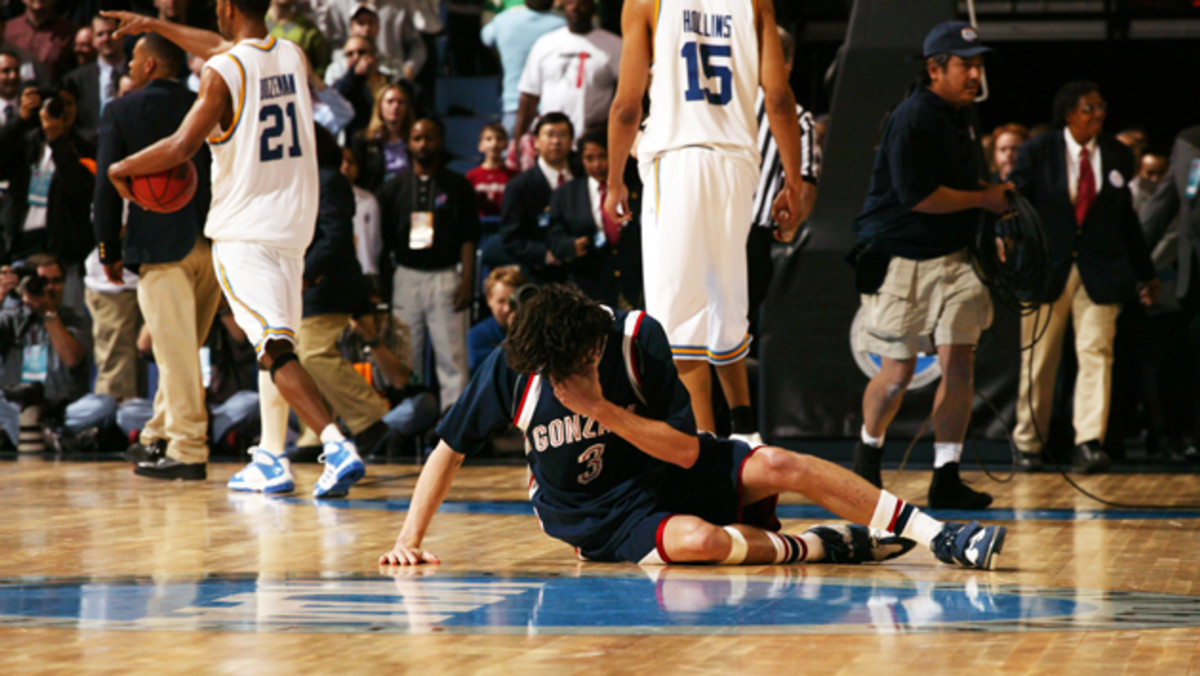One win away from first-ever Final Four, Gonzaga again an underdog

HOUSTON—Friday night, after a program that has never been to the Final Four beat one that has won 11 national championships, the winning coach addressed his players. He reminded them: We expected to be here. We expected to be in this Elite Eight game. We expected to be playing Duke.
Mark Few probably didn’t have to say it. His Gonzaga players understand. Kevin Pangos, Kyle Wiltjer, Przemek Karnowski and friends won 22 games in a row this year. They literally cannot remember a time when Gonzaga didn’t make the NCAA tournament.
To them, Gonzaga is a stable powerhouse. Few has worked at Gonzaga for 26 years and has been head coach for 16. One assistant, Tommy Lloyd, is in his 14th year; another, Brian Michaelson, played at Gonzaga early in Few’s tenure. The director of basketball operations has worked at Gonzaga for 20 years, the athletic trainer for 16, the strength coach for nine, the administrative assistant for seven. Athletic director Mike Roth started working at Gonzaga in 1982.
• MORE CBB: Follow the entire tournament on our live bracket
These Gonzaga players don’t know what it was like, back in 1999, when this all began. How could they? The Gonzaga program is like one of those rubber-band balls that just gets bigger with every rubber band you add, and now this year’s team is bouncing this big ball, and it’s hard to believe that it all started with a single rubber band.
But it did.
*****

It’s funny to look back at it now, but when this all started, people figured Gonzaga could not sustain success. That was the defining characteristic of the place. That was made its run in the 1999 tournament so magical.
Gonzaga was a 10-seed making its second tournament appearance ever. This was before George Mason, before Virginia Commonwealth, and before Butler. There were upsets, sure. And once in a while a big-conference school that struggled during the regular season would go all the way to the Final Four. But the tournament’s little guys rarely made it out of the first weekend, and when they did, they usually got crushed in the Sweet 16.
Gonzaga was different. After beating Minnesota in the first round, and second-seeded Stanford in the second, the Bulldogs flew to Phoenix and beat No. 6 seed Florida. And then they faced the No. 1 seed, Connecticut, which would go on to win the national title, and you had to figure that would be a blowout. It wasn’t. Gonzaga took the Huskies down to the final minute.
Justise Winslow celebrates birthday, homecoming by leading Duke to win
To that point, it may have been the greatest run by a small-conference school in the modern history of the tournament. And it felt like one of those gondola tours over Spokane Falls: A lot of fun, sure, but as soon as you can get out, you do.
The coach, Dan Monson, saw it that way. He did the typical coach thing: He jumped at whatever big job that happened to be available. Monson went to Minnesota, which was in NCAA jail and gave him the kind of contract that is very hard to turn down—long-term and a lot of money—to ensure that he could build a program after the sanctions subsided. Monson’s teams in Minnesota were O.K., but he never got the program to the NCAA tournament, and early in the 2006-07 season he was forced out. (He ended up at Long Beach State.)
Meanwhile, Few took over and kept winning. Not that the nation really noticed. Some people were still skeptical about the Bulldogs, and some of those people were on the selection committee. The Bulldogs were a 10-seed in Few’s first year and made the Sweet 16. The next year they were a 12-seed. They made the Sweet 16 again. In 2003, they went 12-2 in their league and had two players (Ronny Turiaf and Blake Stepp) who would get drafted into the NBA. They were given a No. 9 seed. They took top-seeded Arizona to double overtime before losing 96-95.
So when did it change? When did the underdog become the big dog?
Tyus Jones's journey from WNBA scout team to Duke freshman star
“It’s probably been gradual over that 17 years,” said Michaelson, the assistant who finished playing for Gonzaga in 2005. “My freshman year was our third Sweet 16. During my career, I remember thinking: We’re an NCAA tournament team every year. We expect to win our conference championship.”
The big shift may have taken place in 2004, when Gonzaga got a No. 2 seed. In 1999 that would have been unthinkable. But the moment when the perception really changed came in 2006, with a single image: Adam Morrison, the national player of the year, crying uncontrollably after his team blew a Sweet 16 game to UCLA. Morrison grew up in Spokane. He was a Gonzaga ball boy and a basketball junkie. Maybe you can have some empathy and understand why he was so devastated. But he was mocked endlessly for it, and it was a signal that Gonzaga was no longer the plucky underdog that everybody loved. Gonzaga was good enough to mock.
In 2004, the Bulldogs moved into McCarthey Athletic Center, a 6,000-seat arena that is always filled on gameday. And as we look at the Gonzaga journey, we might as well consider the mode of transportation. Michaelson said when he played, the Bulldogs might have chartered a flight for one game a year until the NCAA tournament.
Starting with the Morrison era, it’s been all charters, all the time.
*****

There is a cost to winning, and it’s not always in dollars, or egos or ethical shortcuts. At Gonzaga, the cost is that magical feeling from 1999. It has slowly evaporated over the years. Under Few, the Zags’s worst conference record is 11-3. Their worst! They are 211-25 in the West Coast Conference. They make the NCAA tournament every single year. How can you be a true Cinderella if you’re always invited to the ball?
“It turned from that underdog role to where people kind of flipped on us,” Michaelson said. “They put expectations on us: You need to do this, this, this, this ...
“The staff here has always done a good job reminding the guys to celebrate every win. Because winning is tough in college basketball. Internally we do a good job of celebrating those wins, but externally it can be hard. We won 22 straight games this year, a school record, and the whole time the public perception is: ‘Well, they should have won that, they should have won that ... they should have won 22 in a row.’”
• MORE CBB: Fun-loving Wisconsin Badgers are back in the Final Four
This has led to the running national storyline about Gonzaga: When will the Zags finally make a Final Four?
Maybe the players love those expectations. They are lucky, though. The people who give Few a hard time usually live far away from Spokane. At home, Gonzaga basketball is still a local treasure, to be savored for what it is.
“The Gonzaga fan base is loyal and it is really, really passionate, but it is not suffocating,” Michaelson said. “When we’re winning, everybody is excited, but when we drop a game, it’s not suffocating. You can get the next one. We have the high-end support without the downside of it.”
Maybe that helps explain why people stay in Spokane so long. It’s not just Few and his staff. Former star Matt Santangelo broadcasts Gonzaga games on the radio. Former star Dan Dickau does many of them on TV. A lot of their teammates live in Spokane, raising kids who play on the same teams together.
“Every one of those guys are pushing for them to get past the Sweet 16, get past the Elite Eight,” Michaelson said. “They truly want these guys to reach a level they’ve never gotten to. There is no animosity or jealousy. Every single guy has wanted each of these guys in the room to have more success than they did.”
Gonzaga expects to be here. We all expect Gonzaga to be here. And most people don’t expect Gonzaga to beat Duke, but maybe that’s good. It means that maybe, after all these years, Gonzaga can have that magical feeling again.
